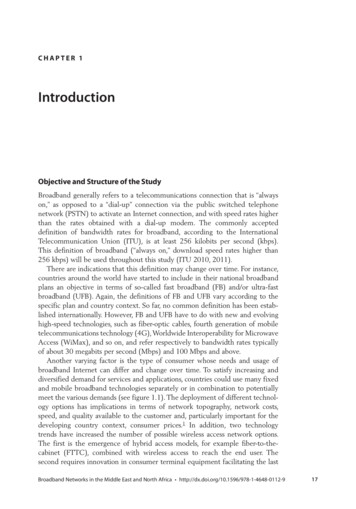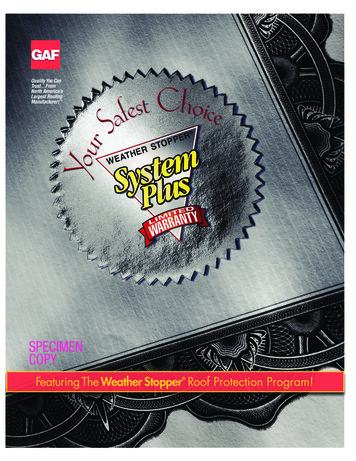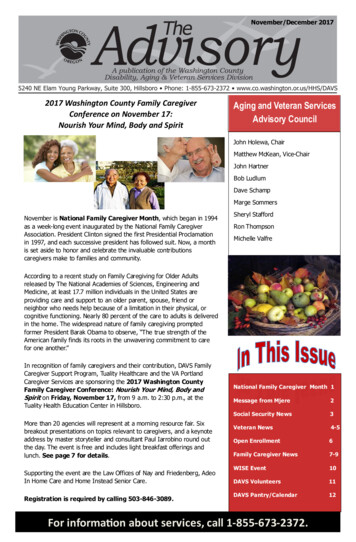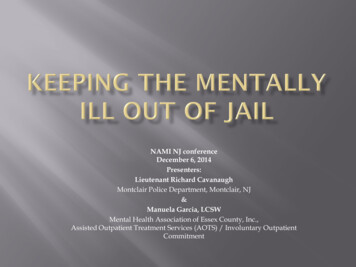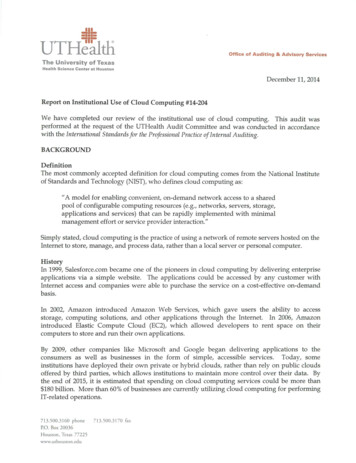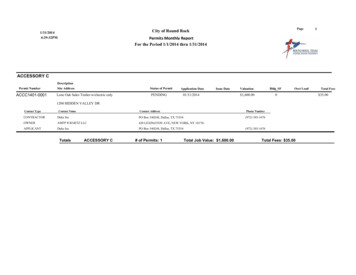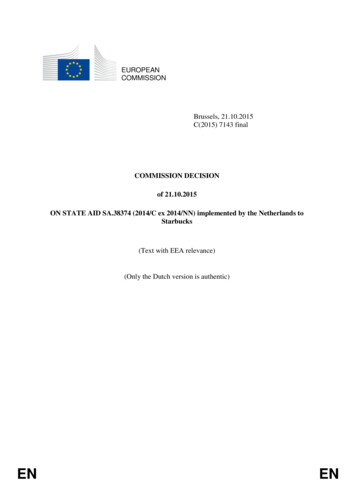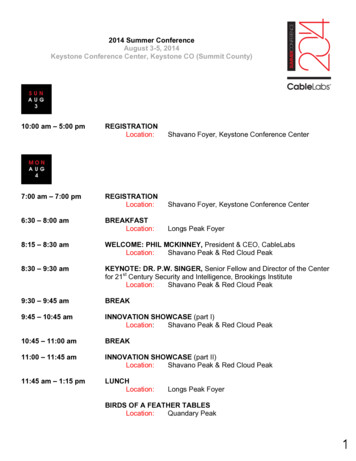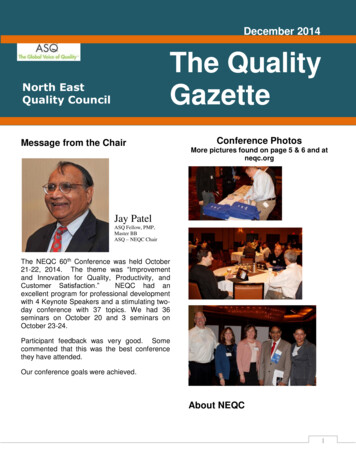
Transcription
December 2014The QualityGazetteNorth EastQuality CouncilNorth EastQuality CouncilMessage from the ChairConference PhotosMore pictures found on page 5 & 6 and atneqc.orgJay PatelASQ Fellow, PMP,Master BBASQ – NEQC ChairThe NEQC 60th Conference was held October21-22, 2014. The theme was “Improvementand Innovation for Quality, Productivity, andCustomer Satisfaction.”NEQC had anexcellent program for professional developmentwith 4 Keynote Speakers and a stimulating twoday conference with 37 topics. We had 36seminars on October 20 and 3 seminars onOctober 23-24.Participant feedback was very good. Somecommented that this was the best conferencethey have attended.Our conference goals were achieved.About NEQC1
What is NEQC?The North East Quality Council (NEQC) is a grouping ofover twenty Sections from Regions 1, 2, and 3 of theAmerican Society for Quality (ASQ), located in the NorthEast.NEQC provides: DatesPast ChairmanSection1953-1956Ervin SchieselSo. Connecticut1956-1963R. S. GoldthwaitRhode IslandFree section volunteer training for potential andcurrent volunteers.1963-1965Francis OlsenWorcester1965-1967Donald S. HolmesAlbanyEducational seminars, conference, and trainingopportunities to ASQ members and non-members.1967-1969Robert PhelpsHartford1969-1971Wes GahaganNorthern N.E.1971-1973Anthony ScaliseMassachusetts1973-1975James FlakerSo. Connecticut1975-1976George MasonBoston1976-1977Al VinceSo. Connecticut1977-1978John PizarMerrimack Valley1978-1980Edward M. StilesHartford1980-1981Edward P. DudekWorcester1981-1983Walter BlonskiDanbury1983-1985George B. LeeThames Valley1985-1987Arthur W. DerbyshireSo. Connecticut1987-1989S. Ken Wiley Jr.Pine Tree1989-1991Daniel J. KeatingNew Haven1991-1993Patricia AudetteRhode Island1993-1995Anthony MartinezMid-Hudson1995-1997George CohenBoston1997-1998Joseph A. TrowbridgeHartford1998-1999Rick W. MacriNew Haven1999-2001Roger KellerBoston2001-2002Lewis DerbyGranite State2002-2003Jay PatelWorcester2003-2005Woody CashmanSpringfield2005-2006Diane DixonWorcester2006-2008Jay PatelWorcester2009-2009Helen Van DiverHudson Mohawk2009-2011Jay PatelWorcester2011-2012Helen Van DiverHudson Mohawk2012-2013Jack ReardonWorcester2013-2014Jay PatelWorcesterScholarships to students from its member sections.Supports sections by providing:o Free member leadership trainingo Seminar discounts for volunteerso One person admittance with discount atconferenceso Communications among sections for sharing“best practices”Free Round Table SessionsMember Sections are:BostonNaugatuck ValleyMerrimack ValleyHartfordGranite StateBerkshireRhode IslandWestern MassachusettsWorcesterOlde ColonyVermontHudson theastern, PANY/NJ MetropolitanSo. ConnecticutMid HudsonLong IslandNorth JerseyNew HavenGreater DanburyPrincetonThames ValleyTappan ZeeSee neqc.org for further detailsNEQC Past Chairs2
Risk-based Thinking in ISO 9001:2015BY JAY P. PATEL, ASQ FELLOWInternational Organization for Standardization (ISO)standards requires organizations to identify and assessthreats, along with their associated risks.Risk ClassificationISO 9001:2015 has taken a different approach to the wayin which its requirements are stated, when compared tothe ISO 9001:2008.To make it really a generic and applicable to all types oforganization producing any type of product or services,ISO 9001:2015 aims to: Harmonize Management System Standards Such asQMS, EMS, En-MS, ISMS, FSMS, ITMS andOHMS Eliminate Unnecessary Documented ProceduresRequirement Introduce Risk Based Thinking Introduce Common Text, Common Structure andCommon TermsThere are 2 types of risks:Business risks: A risk of a gain or loss e.g. a product caneither gain or lose moneyPure (Insurable) risk: Only a risk of loss Example: Fire,theft, which Can be transferred to another party byContracting, Warranty or Insurance.Two primary principles of quality risk management are:1. The evaluation of the risk to quality should bebased on scientific knowledge2. The level of effort, formality and documentationof the quality risk management process should becommensurate with the level of risk.What is Risk?Risk Management PlanningRisk management principles are effectively utilized inmany areas of business and government includingfinance, insurance, occupational safety, public health,pharmaceutical, pharmaco vigilance, and by agenciesregulating these industries.Risk Management planning is the process of decidinghow to approach and plan the risk management activitiesfor a project. It is important to plan for risk management,determine right level, type and visibility of risk, Identifyand validate stakeholders risk thresholds and generate therisk management plan.Risk is defined as the combination of the probability ofoccurrence of harm and the severity of that harm.However, achieving a shared understanding of theapplication of risk management among diversestakeholders is difficult because each stakeholder mightperceive different potential harms, place a differentprobability on each harm occurring and attribute differentseverities to each harm.ALL RISKSInternal RISKSMgt. RisksTechnologyRisksExternal RISKSCommercialRisksRegulatoryRisksInitiating a Quality Risk ManagementProcessQuality risk management should include systematicprocesses designed to coordinate, facilitate and improvescience-based decision making with respect to risk.3
Possible steps used to initiate and plan a quality riskmanagement process might include the following: Involve experts, stakeholders etc.Risk Control Define the problem and/or risk question,including pertinent assumptions identifying thepotential for riskAssemble background information and/or data onthe potential hazard, harm or human healthimpact relevant to the risk assessmentIdentify a leader and critical resourcesSpecify a timeline, deliverables, and appropriatelevel of decision making for the risk managementprocessOverview of a Typical Quality RiskManagement ProcessRisk response planning develops the options and actionsto enhance opportunities and reduce threats to projectobjectives and Includes identification and assignment ofindividuals to take responsibility for each agreed uponrisk response.It uses 4 major response strategies Avoidance Transference Mitigation AcceptanceOutput is a risk response planRisk ReviewRisk management should be an ongoing part of thequality management process. The output/results of therisk management process should be reviewed to take intoaccount new knowledge and experience.InitiateQuality Risk Management ProcessRisk monitoring and control keeps track of the identifiedrisks, monitors residual risks, identifies new risks, ensuresexecution of risk plans and evaluates effectiveness.Risk IdentificationRisk CommunicationRisk EvaluationUnacceptableRisk ReductionRisk AcceptanceRisk Management ToolsRisk AnalysisRisk Process OutputReview EventsRisk IdentificationRisk identification is the process of determiningwhich risks might affect the project and documentingtheir characteristics such as: Locate risksDisplay internal and external risk sourcesDisclose causes and effects of risksIt is advisable to Conducts risk reviews periodically andIdentify new risks that might results from changes andImplement risk response plans if risks occur.While accepting risk “How much is too much” needs tobe specified for each risk. Example: More than 2 workingdays delay in installation of X not acceptable. Thereforethreshold here is 2 working daysBenefits of Risk ManagementFollowings are the salient advantage of having riskmanagement strategy in place: Protects project objectives Maximizes results of positive events Minimizes consequences of adverse events Minimizes unpleasant surprises Focus on building right the first time Proactive not reactiveAuthor: Jay P. Patel is an ASQ Fellow, Master BB,Lean Expert, PMP, Risk Management Professionalwith 10 ASQ Certifications, and many othercertifications, for more info or questions, contactjayp@qpsinc.com4
Member Leader TrainingThank you for your participation in the recent MemberLeader Training in Regions 2 and 3.are posted. Find information on the website by clickingthe tabs along the top. Join the fun and network withlikeminded professionals!Photos from NEQC ConferenceNew Executive Committee 2015Chair: Gil AndradeVice Chair: Dan SneizekSecretary: Karen SzczurTreasurer: Emile NajamImmediate Past Chair: Jay Patel2014 R. Shaw Goldwait AwardThe NEQC R. Shaw Goldwait Award is presented inrecognition of outstanding contributions to the QualityProfession in the previous year. The 2014 R. ShawGoldwait Award was presented to Gil Andrade.ScholarshipThis year, our scholarship award of 1000 recipient isNoah Gurzenski from Western Massachusetts. He is theson of Jim Gurzenski, ASQ member from Western MASection.BosconBoscon will be held on April 14, 2014, at The ConferenceCenter at Waltham Woods, Waltham, MA.For details go to www.asqboston.org.ASQ North Jersey ConferenceASQ North Jersey Section 304 will have its 37th AnnualSpring Quality Conference (SQC) to be held at theMarriott Hanover, Whippany, New Jersey, on April 2,2015. Full day with continental breakfast, 4 course lunch,4 tracks, 15 speakers, vendors, and outstandingnetworking opportunities. Keynote speaker: Bob Miglani,Senior Director–External Medical Affairs, Pfizer, Inc. andbestselling author. SQC program posted on our websitehttp://www.springqualityconf.org/. Brochure and details5
Photos from the NEQC ConferenceKeynote SpeakersJay Patel, NEQC Chair,presenting recognitionawards to Keynote Speakers.Left to right:Thomas Pyzdek; RoseBaczewskiBaskar Kotte; Matt EpiscopoSee neqc.org for morephotos of theconferenceConference AttendeesOne of the 37 Conference Track Programs6
American Society for Quality (ASQ), located in the North East. NEQC provides: . 1977-1978 John Pizar Merrimack Valley 1978-1980 Edward M. Stiles Hartford 1980-1981 Edward P. Dudek Worcester 1981-1983 Walter Blonski Danbury 1983-1985 George B. Lee Thames Valley 1985-1987 Arthur W. Derbyshire So. Connecticut 1987-1989 S. Ken Wiley Jr. Pine Tree 1989-1991 Daniel J. Keating New

